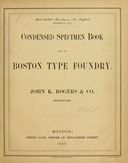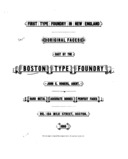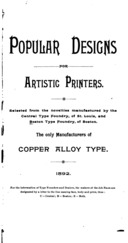1817-1892. Boston. Formed from the sale in 1817 of the Charlestown branch of White's Type Foundry to Timothy Bedlington (a bookbinder) and Charles Ewer (a bookseller). Hired Eward Haskell (plant manager) and Edward Pelouze, Sewell Phelps, Michael Dalton, and Edwin Starr (all became independent typefounders in the future). Edwin Starr left in 1923 to form Edwin & Richard Starr (and then went on in 1824 to the New England Type Foundry), but was back at the Boston Type Foundry in 1826 (Annenberg 115). He may have left in 1827 (to partner with Stephen Sturdevant on a typecaster), but certainly had left by 1832 when he went to the Baltimore Type Foundry). Also employed James Conner, who left in 1827 to form his own stereotyping plant (which added typefounding in 1829 and became a major firm).
Complex and oblique crosslink: in 1815 (?), one Jedidiah Howe, in imitation of and competition with the stereotype works of David Bruce, opened a stereotype foundry in NY. In 1823 he closed it and apparently did two things. (1) He was employed by the Boston Type Foundry to establishe a stereotype department, using some of his equipment. (2) He took the rest of his equipment and entered into partnership in Philadelphia with the already-established Philadelphia stereotyper Lawrence Johnson. Johnson and George F. Smith (but apparently not Howe?) purchased Binny & Ronaldson in 1833, turning it into its next incarnation, Johnson & Smith. Annenberg gives no indication that any typefounding experience or materials cross-fertilized in this link between these foundries.
Destroyed by fire in 1824 (except for mats in vault). Annenberg (p. 72) notes: "In 1826 it was the first type foundry to attempt the manufacture of type by machinery. It continued its experiments in this direction for five years, after which it reverted to hand mold casting." He gives no details of this machinery, which would have predated Bruce's pivotalcaster.
In the 1840s the Boston Type & Stereotype Co. became the first users of David Bruce's pivotal typecaster (which had been offered by Bruce to his uncle, George Bruce, who had declined it).
In 1851 sold to John K. Rogers, David Watson, and Edward Pelouze, Sr. The firm's name became (somewhat curiously) "John K. Rogers, Agent" (Annenberg, p. 73) or "John K. Rogers & Co." (Annenberg p. 212), and the foundry's name "The Boston Type Foundry."
1888. Purchased by James A. St. John and Carl Schraubstadter, Sr of the Central Type Foundry.
Sold for cash into American Type Founders at its creation in 1892. { Annenberg, 70-77}

1856. Supplementary Specimen Sheets
David W. Peat has reprinted the 1856 Supplementary Specimen Sheets, From the Boston Type Foundry. This was beautifully printed by Richard Hopkins at his Pioneer Press of West Virginia and is (in 2011) available from David Peat at 1225 Carroll White Drive, Indianapolis, IN 46219. 36pp total, with a new introduction.

Condensed Specimen Book (1860)
Condensed Specimen Book from the Boston Type Foundry. (Boston: John K. Rogers & Co., 1860). A digital version of this book, including the original page scans, is available at The Internet Archive; the link at left goes there. Here is a local copy of the PDF version and the (nicer) DjVu version.

1880.
Original Faces Cast by the Boston Type Foundry . (Boston: John K. Rogers, 1880.) This has been digitized by Google Books, and is available via The Hathi Trust. The link here is to that digitization. Here is a local assembly of that digitization in a single file (it is rather large, at 298 Megabytes): boston-rogers-1880-google-hathi-nyp-33433006350783.pdf

1892. Popular Designs for Artistic Printers. [Central & Boston]
Popular Designs for Artistic Printers. [title as it appears on the title page, not the cover] (St. Louis, MO and Boston, MA: Central Type Foundry and Boston Type Foundry, 1892.)
This specimen was produced at a point of great change in the American typefounding industry. The owners of the Central Type Foundry (Schraubstadter and St. John) had purchased the Boston Type Foundry in 1888. This specimen book, a joint effort of the two type foundries, is dated 1892. That is the year in which both companies were sold into the newly formed American Type Founders amalgamation. The bulk of the specimen book itself makes no reference to ATF. However, a final page (which is typographically distinct from the rest) advertises "Original Type Designs" for sale by many of the type foundries which amalgamated into ATF (two of which are noted as "Owned and Operated by the American Type Founders' Company"). On its title page this specimen refers only to the Central and the Boston foundries, but the cover of this particular copy bears the title "Artistic Novelties for Printers, for sale by Boston Type Foundry, Boston." It seems reasonable to conclude that this specimen was prepared jointly by the Central and Boston foundries before the formation of ATF but that this particular copy was published by the Boston Type Foundry after the formation of ATF. Many of the larger foundries which combined into ATF retained separate identities for several years. (Annenberg, in Type Foundries of America and their Catalogs, indicates that the Central did not produce a specimen under the ATF name until 1895.)
The icon here links "up and over" to a presentation of this volume in the Boston Type Foundry Notebook.
All portions of this document not noted otherwise are Copyright © 2011 by David M. MacMillan and Rollande Krandall.
Circuitous Root is a Registered Trademark of David M. MacMillan and Rollande Krandall.
This work is licensed under the Creative Commons "Attribution - ShareAlike" license. See http://creativecommons.org/licenses/by-sa/3.0/ for its terms.
Presented originally by Circuitous Root®
Select Resolution: 0 [other resolutions temporarily disabled due to lack of disk space]